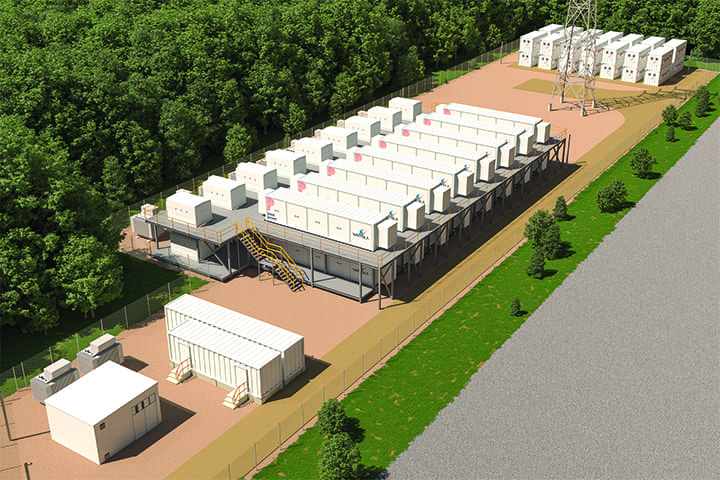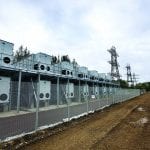The market for energy storage is growing quickly in the UK, with investment companies helping develop projects and noting it could help spur the power sector’s recovery from the coronavirus pandemic. Though the COVID-19 outbreak is pushing some installations into 2021, there is still plenty of storage capacity in the pipeline and several groups expect to have construction underway by the end of the year.
Recent analysis from Solar Media Market Research says there are 1.3 GW of ready-to-build battery storage projects in the UK, most with 30 MW to just below 50 MW of power output. The group also said the total pipeline of battery storage projects in the UK has reached 13.5 GW, including 5.7 GW “with planning permission (but without approved grid connection),” and another 6.5 GW of proposed or planned projects.
Renewable UK, the country’s leading trade association for renewables, in a recent report said that “While the majority of current projects are a combination of gas plants with storage to take advantage of grid connections, we are seeing an increase in applications for solar projects combined with batteries in England and a growing interest for onshore wind collocated projects in Scotland and offshore wind as well.” The group said major players in the market include EDF, Pivot Power, Statera, and RES, “with each company active in several power supply and flexibility markets, providing services to National Grid, Distribution Network Operators (DNOs), as well as operating in the wholesale energy markets.”
Companies such as Siemens and Highview Power are developing ammonia, hydrogen, and compressed air technologies for storage, and Renewable UK said the country has more than 600 MW of liquid air or compressed air storage projects in development. Other companies in the space include Gravitricity (gravity-based storage), OXTO Energy (flywheels in energy storage), and RheEnergise, which is developing dense liquids as an alternative to pumped storage.
The Intelligent Land Investments (ILI) Group, a Hamilton, Scotland-based renewable energy developer, in late June announced it—along with fellow owners The Abbey Group and Yoo Capital—had completed the first sale of one of its 12 energy storage projects in Scotland. ILI sold a 50-MW facility at Ferrymuir in Fife to Gore Street Capital Energy Storage Fund. Gore Street will now manage the project’s construction and expects to bring the facility online in 2022.
Mark Wilson, CEO of ILI, which is involved in three pumped storage hydro (PSH) projects in Scotland, in an interview with POWER said, “You can’t have renewables without storage, and PSH is the most efficient, most environmentally friendly, most proven technology for providing storage.”
 |
|
1. The Intelligent Land Investments (ILI) Group has three pumped storage hydro projects in Scotland, including the 450-MW Red John Project at Loch Ness. The installation includes 50 MW of battery storage capacity. Courtesy: ILI Group |
ILI’s three PSH projects, with a total 2 GW of capacity, include the Red John Project at Loch Ness (Figure 1). “That project is going to be 450 MW, with 50 MW of battery [storage] alongside it,” Wilson said. “And we have two other projects, both up to 800 MW, so potentially 2 GW in the pipeline. Working with AECOM, we’ve looked at 130 sites across the country over the past few years, and we’ve whittled it down to what we think are the best three projects. Scottish government is very pro-renewables, very pro-pumped storage. The UK government also has been extremely positive with renewables, and starting to recognize the need for energy storage.”
Wilson started ILI in 2004 as a company focused on finding “strategic land in Scotland for housing.” Its business model was to work with private investors rather than big banks to fund those projects, and then pass them over to a major developer. Wilson said that after the 2008–2009 crash of the housing market, “we took the same model and moved it to renewable energy,” where ILI focused on onshore wind, putting “small-scale wind turbines on farmers’ land.” He said that when the UK began phasing out coal-fired generation, and adopted a subsidy scheme for renewables, “that was what brought us to storage. We thought if we could do that in volume it would be quite interesting. We didn’t see ourselves being in wind long-term… with those coal plants closing down, and all the intermittency [from renewables] coming online, we saw that there was a real need for energy storage.
“We looked at compressed air, at salt caverns, we looked at hydrogen, we looked at lithium battery, we looked at pumped storage. Scotland has the topography, and it’s a proven technology. When we were on the journey with wind, we saw how hard it was to get money for new technology. Pumped storage [as a proven technology] checked that box, and we knew we could get it funded,” he said.
According to Wilson, his group is looking to provide Scotland with long-term storage through projects like Red John, and with battery storage as well. He noted that Scotland’s power grid is constrained, and wind farms are turned off when there is an oversupply of electricity. Energy storage projects are expected to help balance the grid. “Together our projects can bring over £2 billion of investment and thousands of jobs to Scotland, energizing local workforces and suppliers in the challenging times that lie ahead,” Wilson said. “These projects will help stimulate the economy in the short term coming out of the pandemic and play a significant role in meeting the UK’s net zero targets.”
Wärtsilä, the Finnish manufacturing company, also is involved in energy storage in the UK, including deploying its GridSolv solution, incorporated with GEMS software, to integrate with the UK power grid, and with electric vehicle (EV) charging stations along highways. GEMS dynamically adjusts according to the demands of the market across multiple revenue streams, allowing Pivot Power—an EDF Renewables company—to both manage and optimize a fleet of large-scale energy storage systems and renewable assets under a single portfolio. These storage projects have created an infrastructure that can scale to accommodate projected growth in the use of electric vehicles throughout the UK.
Risto Paldanius, director of business development for Wärtsilä, told POWER the company “is primarily focused on large-scale in-front-of-the-meter projects, working with UK investors, developers, and asset owners who have developed or acquired portfolios of energy storage projects. We offer all the necessary requirements, from equipment through to full turnkey EPC [engineering, procurement, and construction contracts], which is all underpinned by Wärtsilä’s sophisticated energy management platform (GEMS), which not only integrates and optimizes storage, but also other assets, such as renewables and engines, enabling customers to innovate with new models or stand-alone projects.”
 |
|
2. Wärtsilä and Pivot Power are installing 100 MW of energy storage for the UK electricity market, installations that will provide essential capacity for rapid electric vehicle charging. The 50-MW installations, in Oxford (shown here) and Kent, are scheduled to be completed by year-end. Courtesy: Pivot Power |
Pivot Power and Wärtsilä are installing 100 MW of energy storage systems that will operate in the UK’s electricity market and provide essential capacity for rapid electric vehicle charging. Two 50-MW/50-MWh projects, one in Kent and the other in Oxford (Figure 2), are scheduled to be completed by year-end.
“The primary drivers Wärtsilä sees in the UK include the need to be able to provide ultimate flexibility to the power system and at the same time the ability to earn adequate revenues from the merchant market,” said Paldanius. “Wärtsilä focuses on how technology can harness this to maximize the lifecycle of the projects to help investors and asset owners achieve these returns. Wärtsilä provides flexible warranties to allow projects to change and adapt to the ever-challenging market dynamics. Wärtsilä also takes the view that software and machine learning-based technology can drive better operational performance, maintaining SOC [state of charge] and overall health of the assets to protect the valuable income streams generated by the project.”
Michael Rossman, co-founder of EnergyBillKill.com, a group that offers business energy switching services for renewable and traditional energy, told POWER that “Energy storage in the UK has two great promises. First, for the national grid and management of electricity at peak and at a low-use level. Second, and potentially even more powerful, is home storage. The first is being led by… innovators like Wärtsilä and EDF,” with Rossman noting the two 50-MW storage projects in Oxford and Kent. He said the potential for home-based storage “is very exciting because it will empower homes [and commercial offices] to be completely energy independent from the central grid. The magic is in the ability to store solar or wind energy ‘while you were out.’ At the moment, if the energy is not sold into the grid, it is effectively wasted. In the near future, homes and offices will be able to store this energy in either batteries or alternative forms such as water. An example of this is Tesla’s Powerwall. Interestingly, the developing world leads energy storage adoption in homes. This is due to regular power interruptions and uncertainty of supply. The future is bright. The future is storage.”
—Darrell Proctor is associate editor for POWER (@DarrellProctor1, @POWERmagazine).










